If there’s one planet that will define the next milestone in human civilization, it’s Mars. You probably have heard from the likes of Elon Musk to NASA to even China on getting humans to Mars. Thus far, we’ve seen the amazing world of Mars through the eyes of our rovers. and orbiters. Now, NASA is launching their latest mission called Mars 2020 on July 30th. This is not any ordinary mission either. It has a ton of firsts and will even answer questions like “was there life on Mars in the past?” It will also be the one to deliver the first Mars helicopter/drone called Ingenuity. That’s amazing for a number of reasons. However, let’s take a look at the objectives for the mission.
Mars 2020 Mission Objectives

Credit: NASA
The mission has a ton of fantastic goals that not only help progress us in understanding things like the origin of Mars and the solar system but also how to protect future astronauts going to Mars. Here are the main objectives1:
1. Look for past microbial life by collecting rocks and soil and sending it back to Earth by future missions
2. Rover will look for ancient habitable environments and monitor the environments to help protect future explorers
3. Study the rocks on the surface on Mars that, especially those that formed in water and could preserve chemical evidence of building blocks of life
4. Rover will demonstrate key technology in converting CO2 from the Martian atmosphere and convert it into oxygen
The one thing you’ll hear from the NASA scientists who talk about this mission is that the rover is set up to find the best samples that may contain organic compounds. Then bringing it back to Earth and studying it with the best labs will yield unfathomable results.
How will Perseverance accomplish its goal?
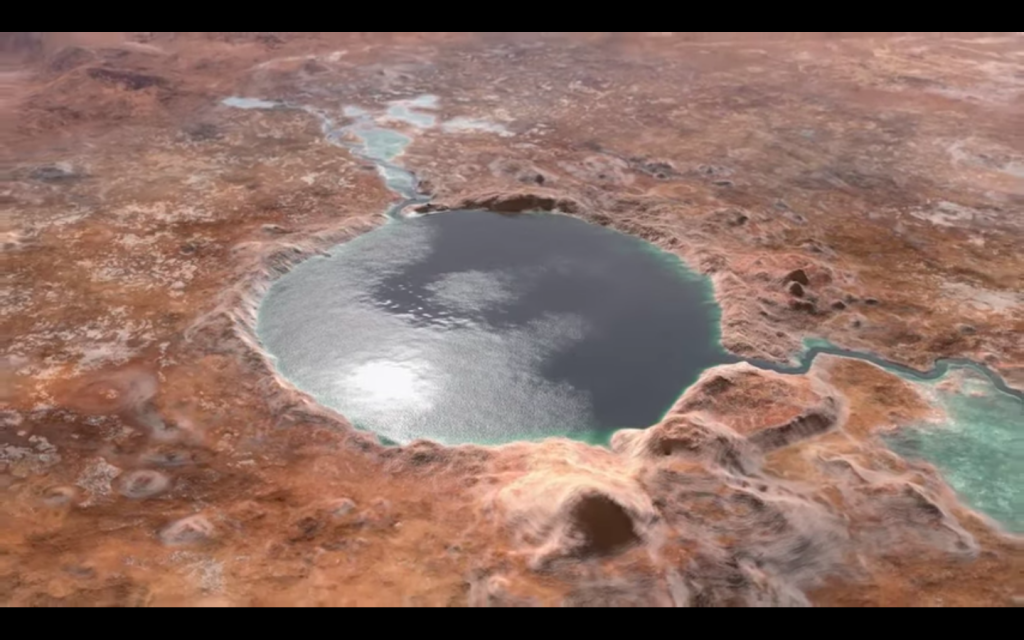
Say hello to a 3-3.5 billion-year-old impact basin called Jezero crater. It is where all the magic will happen. Jezero is actually an ancient lake, and no there is no flowing water there today. However, why this became a top contender is because it had two clear features of an inflow and outflow as you can see in the illustration. That only occurs with an open body of water and water flows in and then flows out elsewhere.
Another thing that makes Jezero crater a prime target is that it has one of the largest and best-preserved delta deposits on Mars. Deltas form when rivers enter open bodies of water and bring over rock, sand and potentially organic carbon. That means it’ll be a rich area to dig and receives samples.
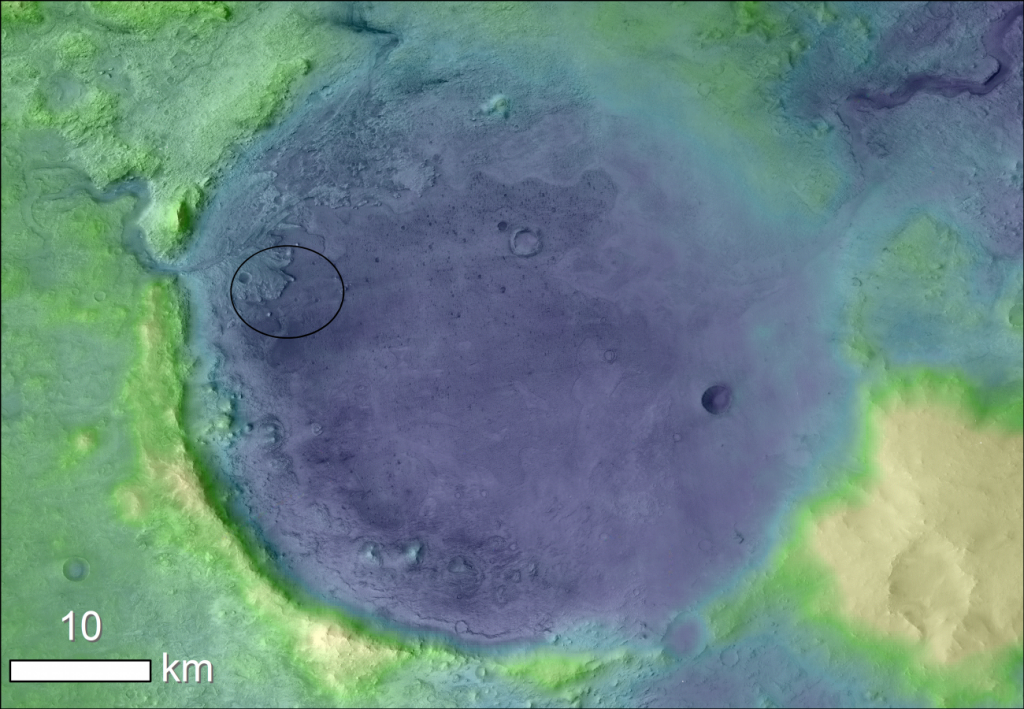
A closer look at the Perseverance rover
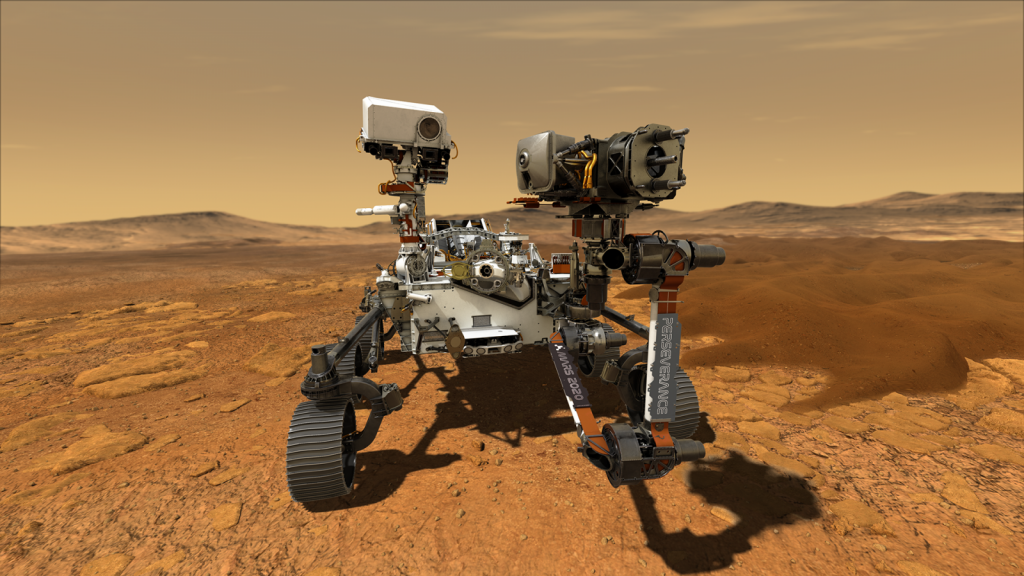
The Perseverance rover looks almost exactly like the Curiosity rover. In fact, here’s a side by side comparison.
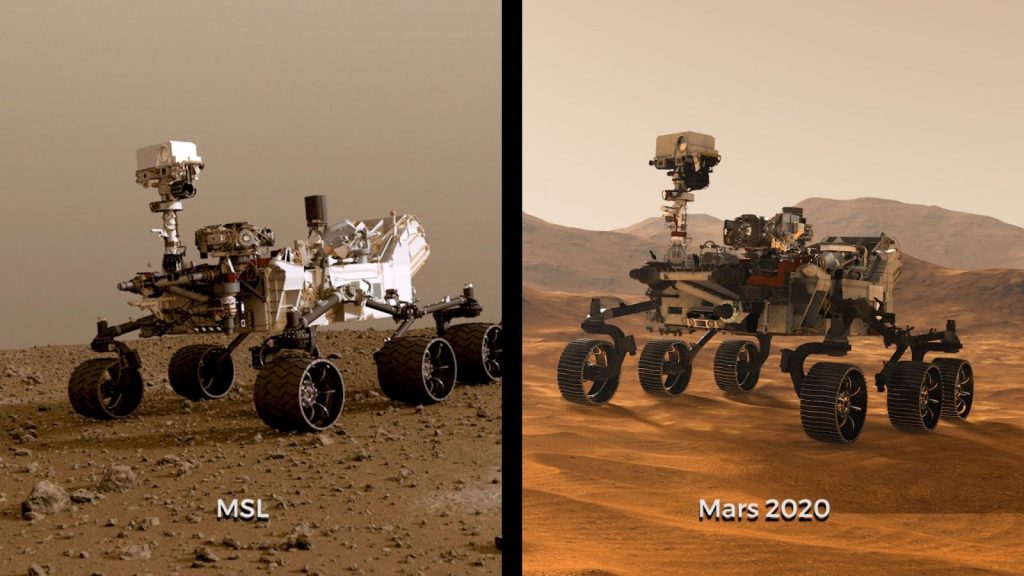
Credit: NASA
Haha, right? What is also great to get a sense of how far we’ve come is this wonderful “Family portrait” of the past rovers.
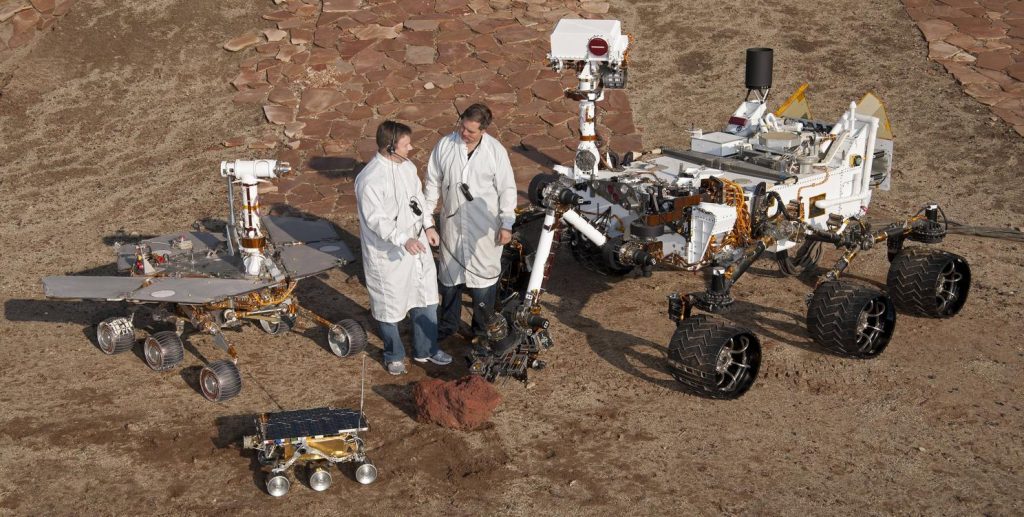
We have Sojourner which was humble and only had two instruments and was launched in 1997. Then the robots became a little more sophisticated with Opportunity and had about 5 instruments onboard as well it could move much faster. Then Curiosity which actually had 10 science instruments vs. Perseverance’s 7.
However, it’s not the number of science instruments that make these rovers amazing but helping us progress at each stage of discovery. Not only that, but these rovers embody the world working together. Here we have Spain, Norway and France that all contributed to the Perseverance rover.
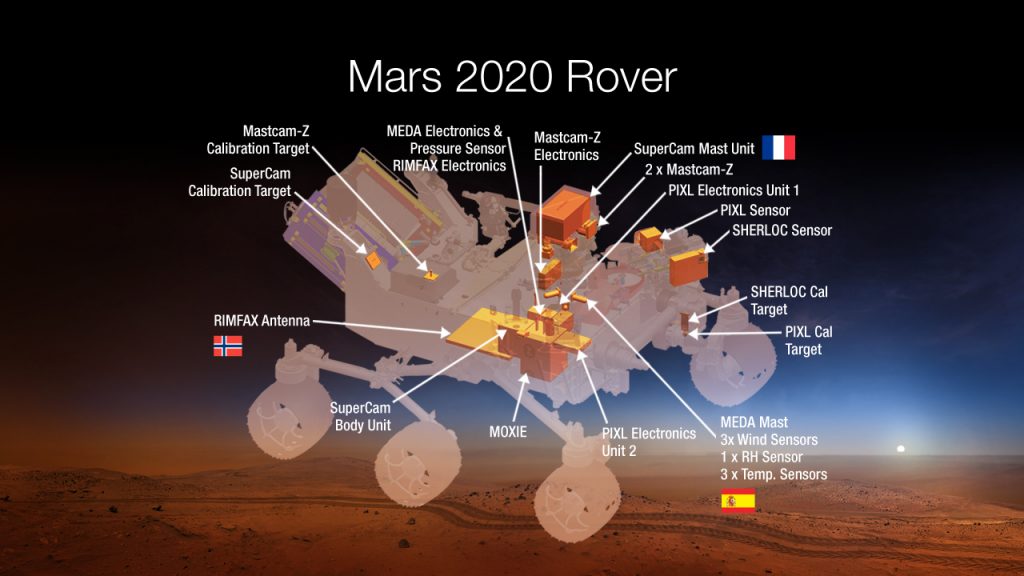
However, what’s even more exciting is what these instruments can do. Let’s take a closer look:
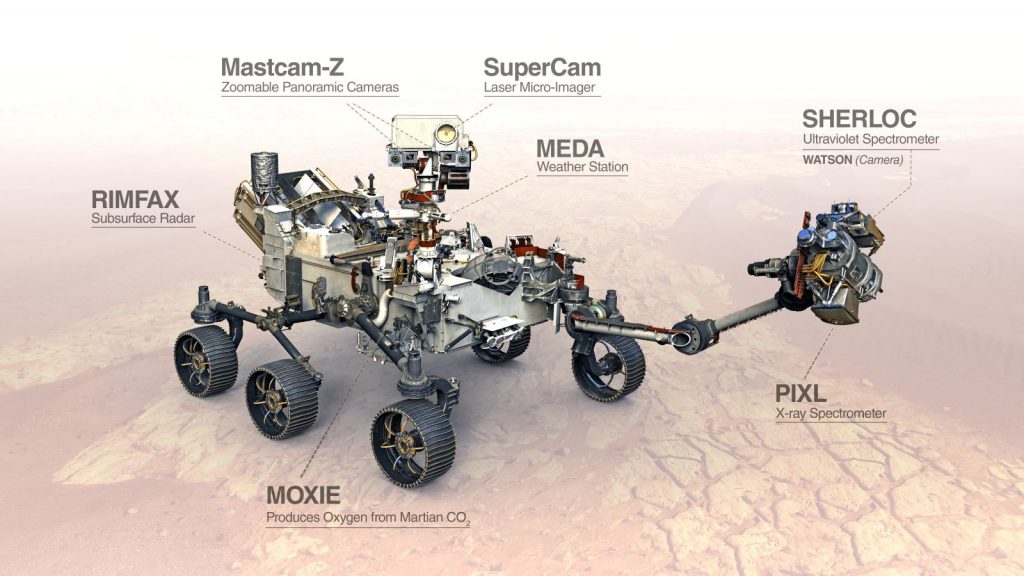
Credit: NASA
Here are all 7 of the science instruments on board the Perseverance rover. These will all work together to help navigate the Martian landscape, look for and take samples that may contain ancient micro-organic life, as well as produce oxygen from the carbon dioxide atmosphere.
SHERLOC or Scanning Habitable Environments with Raman & Luminescence for Organics & Chemicals along with WATSON which stands for Wide Angle Topographic Sensor for Operations and eNgineering. These two are amazing instruments. SHERLOC is named appropriately because it’ll actually “dust” for fingerprints or detects fine minerals, organic molecules and potential biosignatures. The way it does that is really in the acronym, specifically Raman and Luminescence.
Raman is actually a way to identify what the chemical makeup of a rock or object is by identifying the vibrational frequency of it or vibrational mode. It’s a spectroscopic technique (the interactions between electromagnetic wavelength and light) that is commonly used in chemistry where they can get a fingerprint and then use it to identify the chemical compound.
The other part which is luminescence is something you’re probably already familiar with if you’ve ever played with a glow in dark materials. Luminescence is where something gives off light through cold body radiation. An easy example is if you’ve ever had a watch where the hands of the clock or the numbers glowed in the dark. Same idea applies but Perseverance will use SHERLOC and WATSON to shoot a UV laser to help identify the chemical compound. Here’s an example of what a rock would look like to Perseverance:
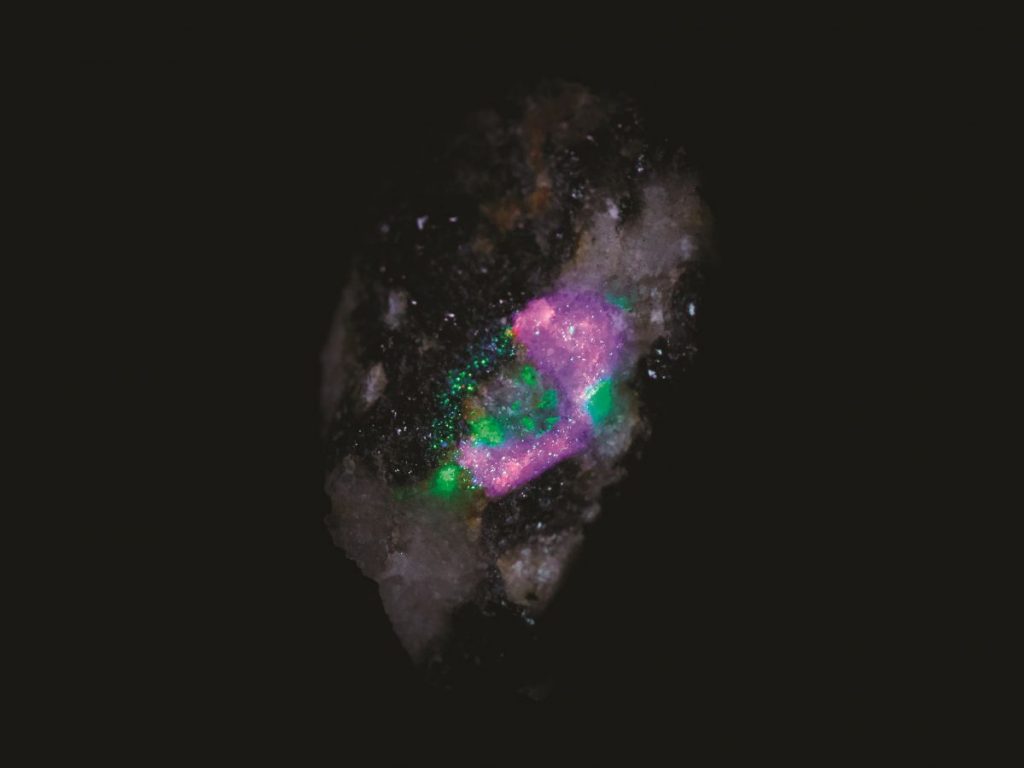
Credit: NASA
As you can see above each colour shows a different mineral as detected on the surface of the rock. Isn’t that cool? SHERLOC and WATSON are perfect names for what they’re doing. Oh and one of the coolest parts is that SHERLOC will carry around a piece of a spacesuit to see how it holds up in the martian environment. This will be incredibly useful information for future Mars astronauts that was to see what their Martian spacesuits will need to be like.
The tough part is how do we know what a biosignature looks like on Mars? We’ve never seen one before so how do we know what to look for? Well that’s where our knowledge of Earth comes in. Here’s what’s called a stromatolite. In non-jargon terms it’s a rock that has micro organisms trapped and fossilized.
The way these form is thinking about pond scum. The gross green parts that float on top of a pond. Overtime these parts get covered in mud and dirt and then eventually this bacteria grows right on top of it. Followed by more mud and dirt that covers it up. This happens back and forth and then throw a billion years or so to the point these are fossilized and then you have a stromatolite! They’re perfect as a time capsule for evidence of ancient organic life. Here’s an example of a stromatolite that is about 3.5 billion years old and was found in Australia.

Credit: Didier Descouens
This stromatolite has layers that represent the evolution over time. And each layer is a microbial mat with fossilized bacteria. Now, you wouldn’t know that this rock had biosignatures but you couple that with the textures as well as the chemical composition, the mineralogy, and the distribution of organic carbon and suddenly you build a case that says this could have only formed with the influence of life.
Our next instrument is RIMFAX or Radar Imager for Mars’ Subsurface Experiment. This is actually the first radar instrument ever sent to Mars. Even though Curiosity has 10 instruments on board it didn’t have a radar.
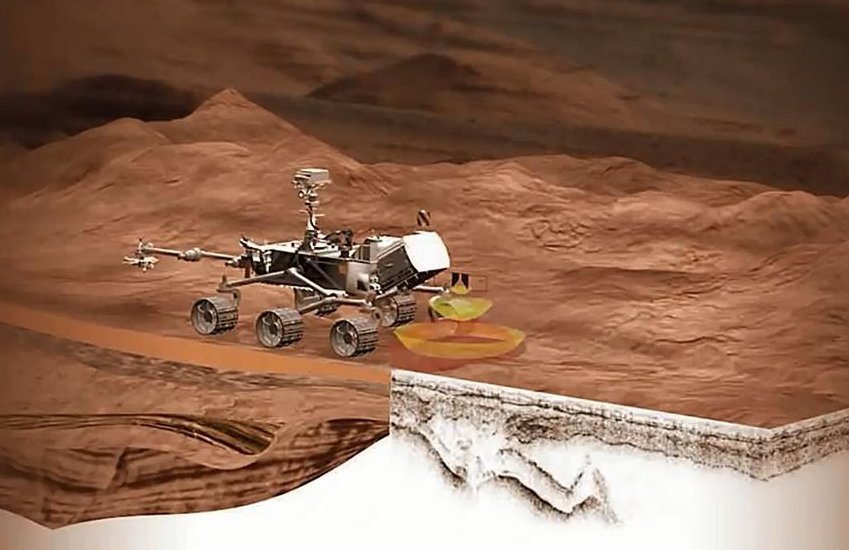
Credit: NASA
This will help uncover what lies beneath the surface or Mars. RIMFAX is based off ground penetrating radar that was used in the Arctic and Antarctic. It can detect water and ice 30 ft beneath the surface. It’ll be amazing and vital for future missions as we’ll know where we could extract water from.
The other fun thing about the Perseverance is that it has 23 cameras!
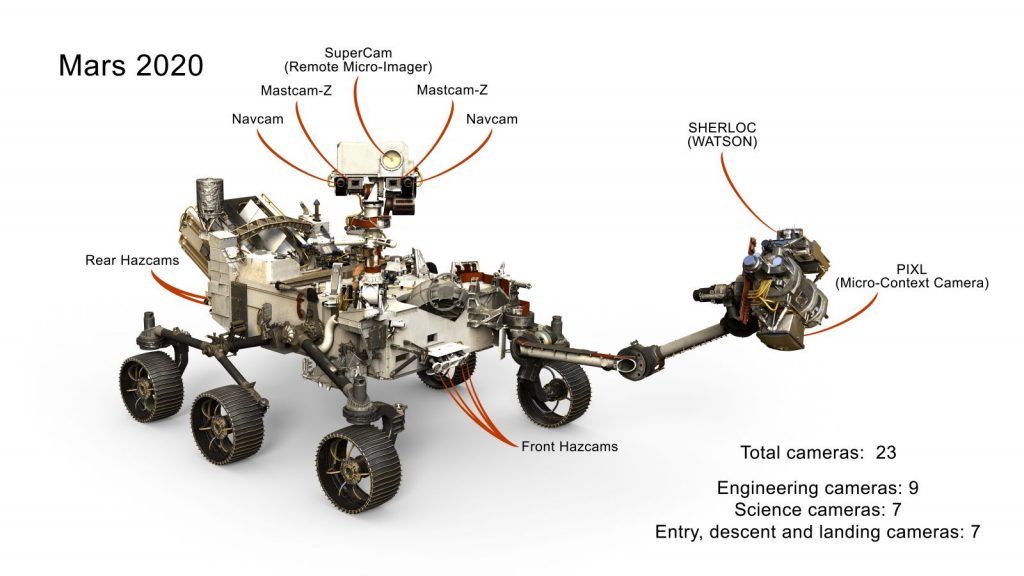
Credit: NASA
These cameras will be a huge help for Perseverance to navigate the land easily as well as keep an eye on Ingenuity. And there are other cameras that’ll help do science as well 🙂
Here’s a list of the other instruments:
- PIXL (Planetary Instrument for X-ray Lithochemistry) – seeks changes in textures and chemicals in Martian rocks and soil left behind by any ancient microbial life.
- MOXIE (Mars Oxygen In-Situ Resource Utilization Experiment) – a really cool instrument that will convert the carbon dioxide in the atmosphere to oxygen
- MEDA (Mars Environmental Dynamics Analyzer) – it’ll monitor the weather and keep track of things like humidity, temperature, wind, pressure, UV, and much more.
A look at Mars’ new helicopter Ingenuity
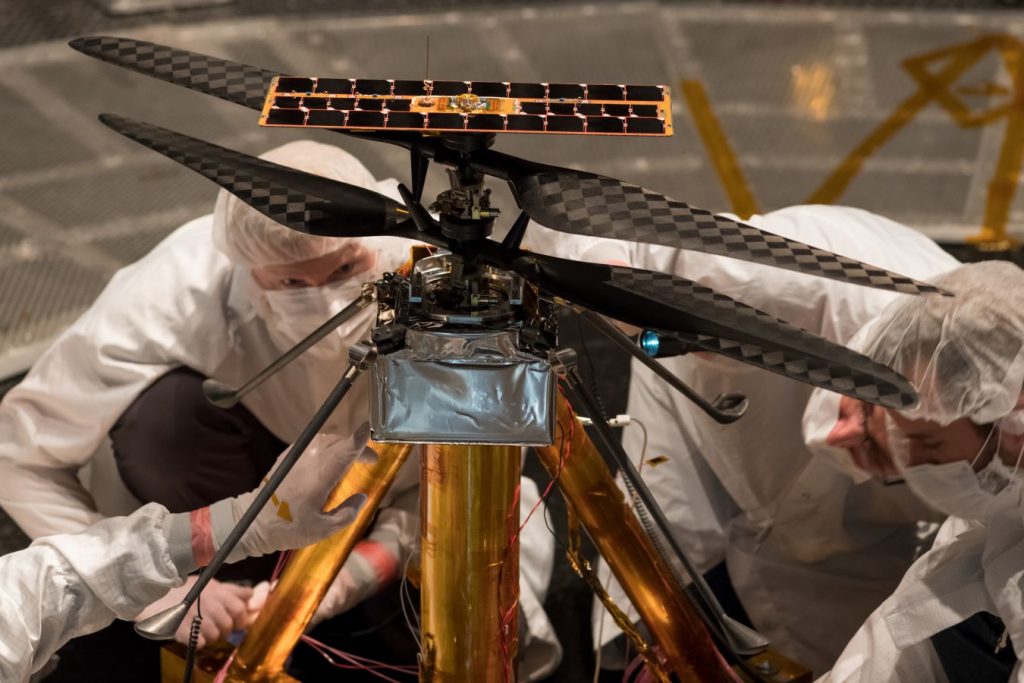
Credit: NASA
If there is anything that made me feel like this mission was out of a sci-fi novel or movie it’s the fact we’re sending a helicopter to Mars! This will be the first self powered flight. The first flight on another planet was actually done by Russia with Vega 1 and 2 which went to Venus! It’s impressive because the balloons lasted about 2 days before they slowly went down and ended up being destroyed by Venus’s violent environment. But I digress. Ingenuity will be solar powered and primarily will be a test flight.
The atmosphere on Mars is about 1% of Earth and the gravity is about 3/8’s. Which means when you’re building a helicopter that won’t get much lift due to the thin atmosphere you’ll need a much bigger rotor.
The helicopter will be fully autonomous and be able to fly back to Perseverance. The rover will be keeping an eye on this little helicopter but it’s said that it will last for about 30 days. However, they also say these rovers are supposed to last a year or a year and a half and they tend to last for almost 10 years sometimes! Here’s a great video of Ingenuity that will give you a sense of what it can do:
This helicopter will be exciting to see how it performs on Mars. Better yet it’ll open the gates for more missions that will have a helicopter on board and be able to explore the planets or moons a lot faster.
A mission that goes beyond a landing: a sample retrieval
Mars 2020 mission is centred around getting amazing rock and soil samples that the scientists can study in their own labs on Earth. It’ll help us answer so many questions as well as we can extract a ton more data. The interesting part is the mission doesn’t end on the surface of Mars. It will be visited by another future mission to retrieve the rocks and soil samples to be sent back to Earth. Here are the steps outlined2:
Step 1: Mars rover takes a sample and stores it
Step 2: In 2026 a fetch rover will be launched to collect the samples and bring them to a rocket that will launch them into orbit around Mars
Step 3: Another orbiter will rendezvous and capture those samples for safe delivery to Earth.
If it sounds complicated, it’s because it is.
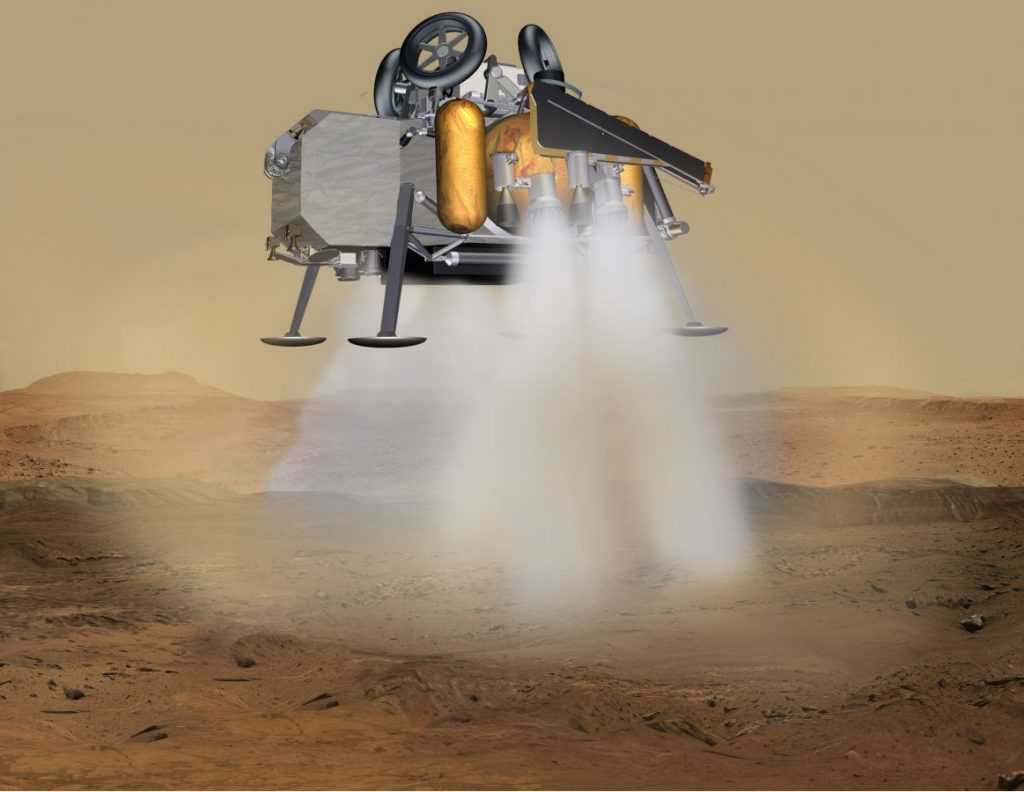
Credit: NASA 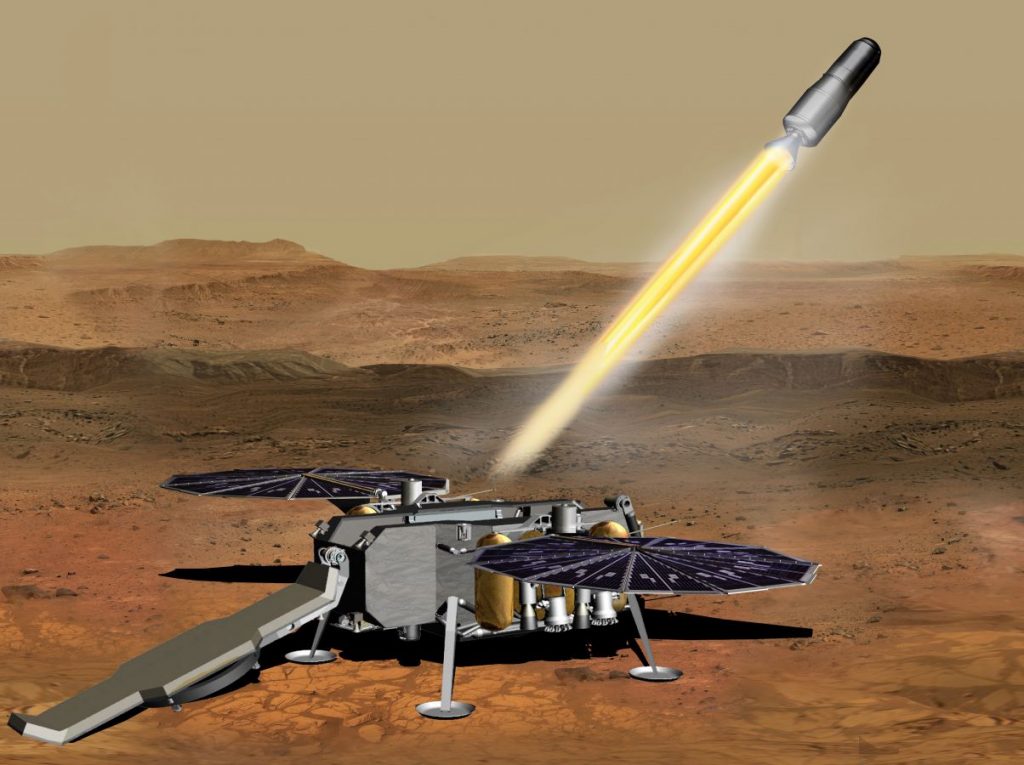
Credit: NASA 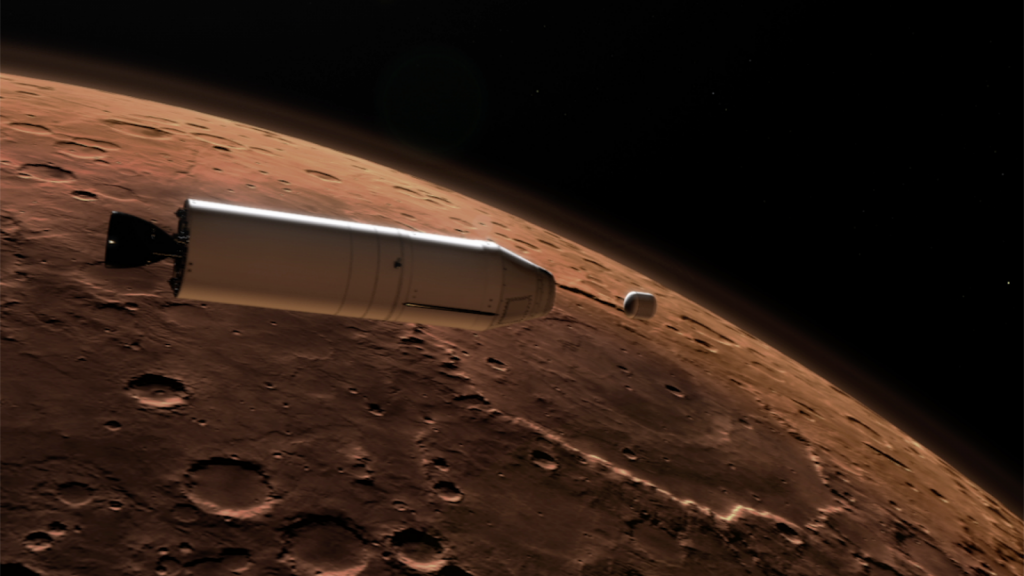
Credit: NASA
The illustrations above give a sense of how a new rover will be sent to Mars and then shoot them back out into orbit to be retrieved.
Atlast V rocket
Like many missions before this, Atlas V has taken on the responsibility to get Perseverance and Ingenuity safely to Mars.
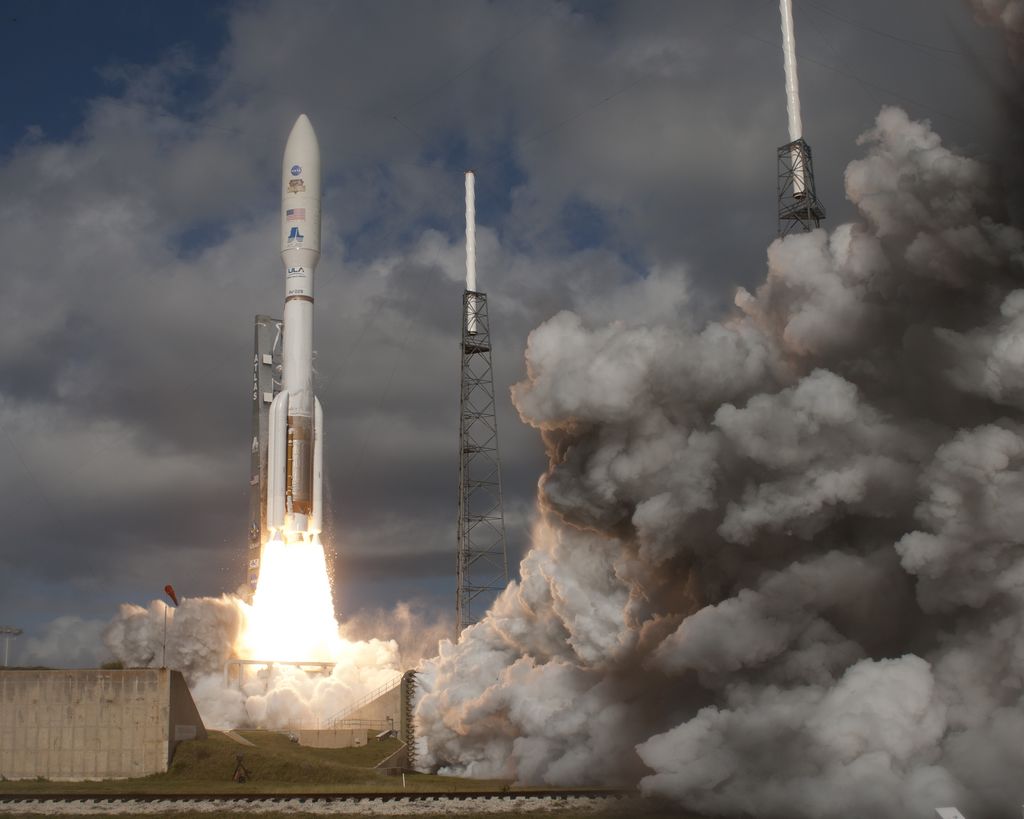
Credit: NASA
The Mars 2020 mission is set to launch for July 30th at 7:50 AM ET if all goes well. It will arrive in February of 2021. The reason why it needs to leave now is because of how Mars and Earth orbit each other.
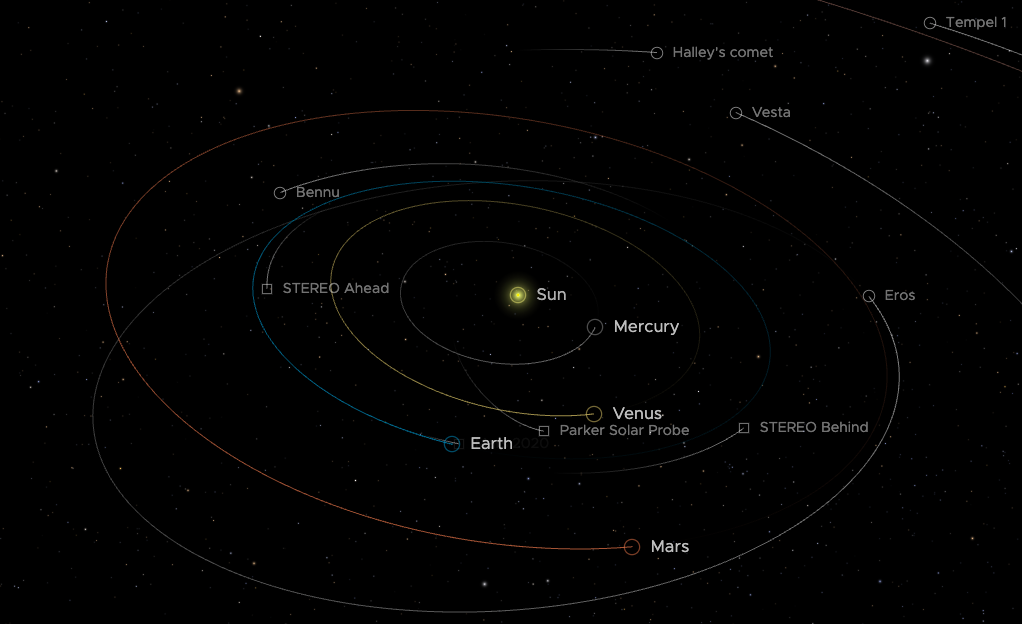
The descent or landing involves the “7 minutes of terror” or a complex set of steps to safely land the rover and helicopter.
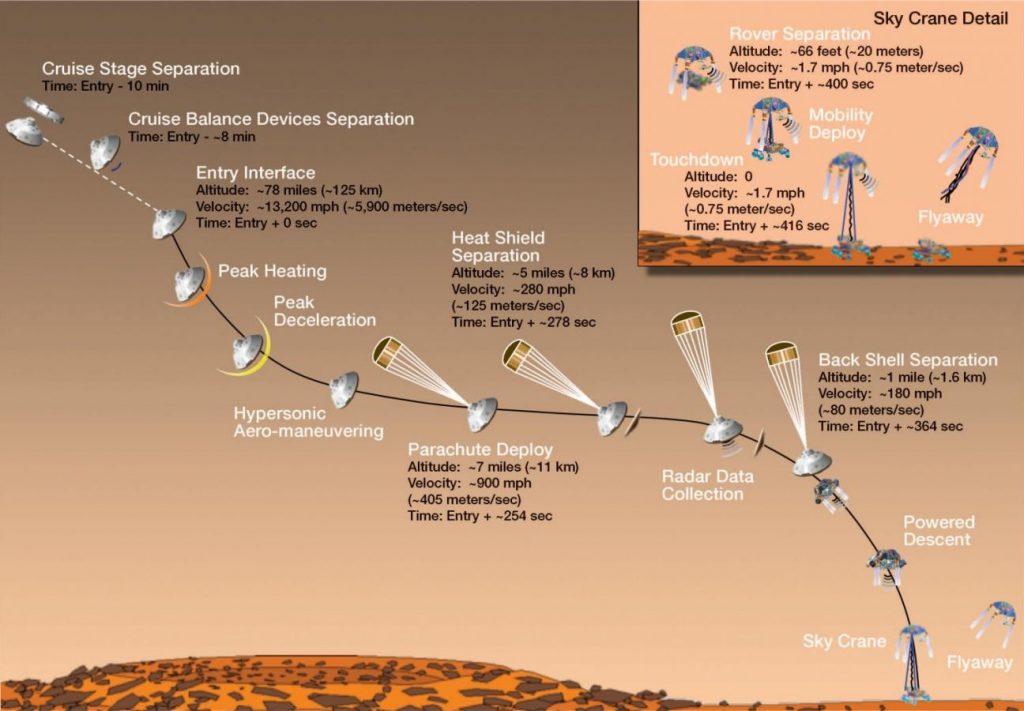
Credit: NASA
It’s called 7 minutes of terror because it’s that fast when it enters the Martian atmosphere and when it finally touches the ground. It’ll use a sky crane to hover after the parachute is deployed and then fly away so that the rover isn’t interfered with at all. We’ll even get to see the entire landing sequence because of the video cameras.
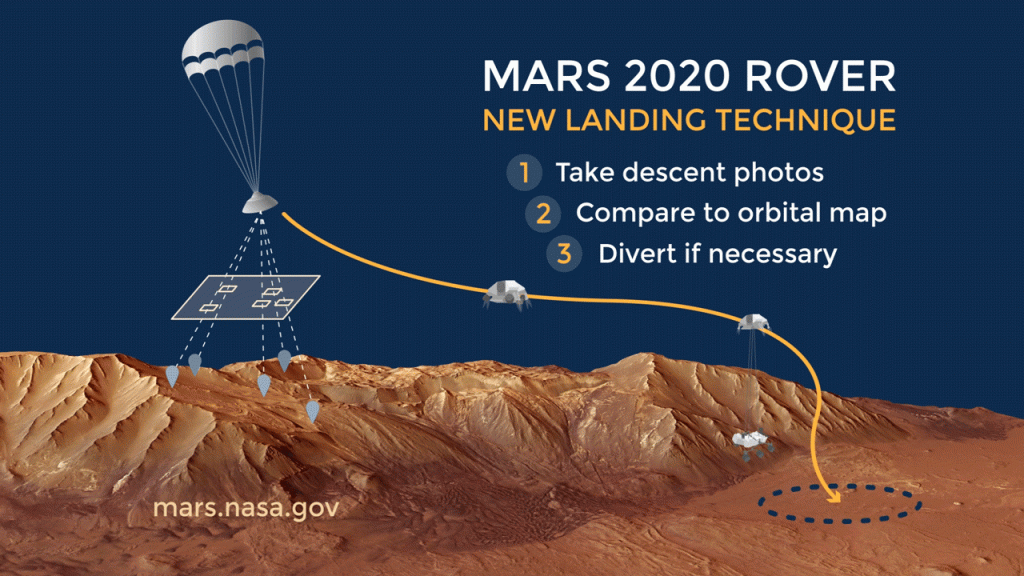
Credit: NASA
Final Thoughts:
Through this mission we’ll learn on whether ancient microbial life existing on Mars or more so – did life exist on Mars? It’s also an ambitious mission to have a set of samples be returned to the lab for a deep dive into martian soil and rock. This also sparks a new era of robots that will be able to fly on other planets or moons. Even on the rover we’ll have microphones which means we’ll get to hear Mars.
Finally, it’ll help prepare our future astronauts as the more data they can get on Mars the more prepared they can be. That also means the safe they can be. It’ll be a really fun mission for all of us to keep our eye on and even more exciting to see in 2030 or so the actual samples that are returned.
